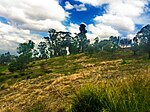Prospect Reservoir

The Prospect Reservoir is a heritage-listed 50,200-megalitre (1,770×10^6 cu ft) potable water supply and storage reservoir created by the Prospect Dam, across the Prospect Creek located in the Western Sydney suburb of Prospect, in New South Wales, Australia. The eastern bounds of the reservoir are a recreational area and the western periphery are within the bounds of Western Sydney Parklands. It was added to the New South Wales State Heritage Register on 18 November 1999.Prospect Reservoir is Sydney's largest reservoir and stores water conveyed from Warragamba Dam, the Upper Nepean Dams (Cataract, Cordeaux, Avon and Nepean) and if necessary, from the Shoalhaven Scheme, for supplying the larger component of the water distribution system of the Sydney metropolis. Located approximately 34 km west of Sydney, the reservoir is a zoned earth embankment dam, 26m high and approximately 2.2 km long, with a storage capacity of 50,200 megalitres and an open capacity of 8,870 megalitres.
Excerpt from the Wikipedia article Prospect Reservoir (License: CC BY-SA 3.0, Authors, Images).Prospect Reservoir
Sydney Wetherill Park
Geographical coordinates (GPS) Address Nearby Places Show on map
Geographical coordinates (GPS)
| Latitude | Longitude |
|---|---|
| N -33.828 ° | E 150.899 ° |
Address
Wetherill Park
2164 Sydney, Wetherill Park
New South Wales, Australia
Open on Google Maps










